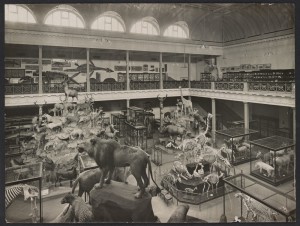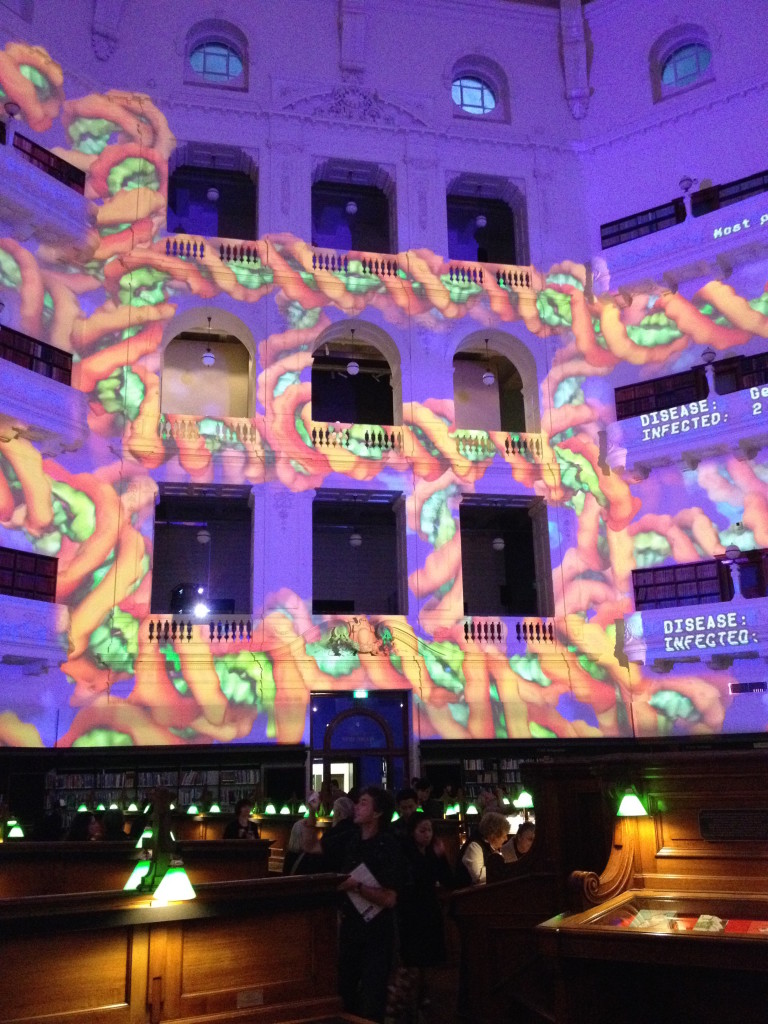I love libraries and library buildings, from the huge New York Public Library to the British Library complete with Kings Library Tower rising up through its St Pancras site; the grand State Library of New South Wales, the venerable Bodleian in Oxford, our National Library of Australia and more. As a Melburnian working in the GLAM sector it’s no surprise I have strong connections with the State Library of Victoria (SLV).
As with many who grew up here, my first memories of the library building are actually of the museum. Museum Victoria and its predecessors spent one hundred years squashed in on the same site as the SLV (the National Gallery was there too until 1968). I used to come in with my family in the 1980s, getting off at Museum Station (now Melbourne Central) to visit its slightly musty halls. My most vivid memories are of a model digestive system, and Peter Corlett’s sculptures illustrating the human body; but we visited the domed reading room then too. I was in awe of its scale and fascinated by the books lining the walls.
Skipping forward to university years, my first ever art history essay was a 1,000 word visual analysis of Emmanuel Fremiet’s Joan of Arc sculpture which stands to the right of the SLV entrance. Later, while working on my Honours thesis, I spent countless hours in the Arts Library, then housed in Queen’s Hall – a wonderful space sadly closed to the public for now except on special occasions. It was my favourite place to hide away from the world.
After that the SLV and I parted ways for a while, though I stopped in every now and then to say hello. Until, in mid-2008, I started work as an archivist. Though employed by the University of Melbourne, my first job was helping list and re-box collections going into the SLV’s repository. On my first day a colleague let me in to the library before it was open to the public. Walking through the huge, deserted Redmond Barry Reading Room I was grinning. Many kids dream of being allowed in a toy store after hours, but for me this was just as good.
Over the months I was based there I got to see behind the scenes; walk the corridors beneath the building where the museum’s maceration tanks sat; use the huge, notoriously unreliable wood-panelled ‘elephant lift’; take occasional shortcuts through the conservation area; and climb the impressive staircase where a Foucault pendulum once hung.
In recent years the connections and intersections between what I do and the SLV and its history have continued to grow. Every time I walk to my office at the University of Melbourne I pass the Foucault pendulum in the School of Earth Sciences which reminds me of the staircase at the SLV. Highlighting the connection, Earth Sciences is in the McCoy Building, named after Professor Frederick McCoy; and for many years the Redmond Barry Reading room on the Swanston Street site was named McCoy Hall. There are some beautiful pictures, like the one below, of it crammed with natural history specimens in the early 20th century.

Unknown photographer, Display of animals and fossils in McCoy Hall, c 1910, gelatin silver photograph, State Library of Victoria
McCoy (1817-1899) was an early professor at the University of Melbourne, and the first Director of the Museum. He brought the collection up to the University campus – you can still see a few remnants of the building he had constructed to house it in the walls of what is now Union House – where it stayed until Baldwin Spencer brought it to Swanston Street after McCoy’s death in the last year of the 19th century.
Starting as an archivist walking through the deserted reading room eventually lead me to where I am now – working on a PhD funded by a McCoy Scholarship, looking at the connection between archival and other collections held by Museum Victoria. These days I’m in and around the SLV regularly for a whole variety of reasons, from lunch at The Moat or an event at the Wheeler Centre to coffee at Mr Tulk and a quick browse in Readings. The domed reading room was my first stop last White Night, and probably will be again this year. Late last Friday I was in the cinema on the La Trobe street side of the building seeing a documentary about Vali Myers. And today I was working in the La Trobe Reading Room looking through annual reports from the time when Museum Victoria was still within those walls, bursting to get out.
Now the museum and gallery have moved to their own sites, the library has had room to expand and is – as with all great libraries – a cultural hub filled with much more than books, while remaining (just as importantly) wonderfully bookish.


Leave a Reply